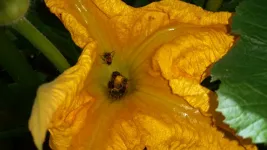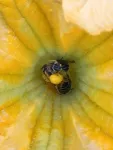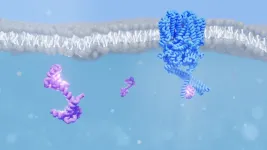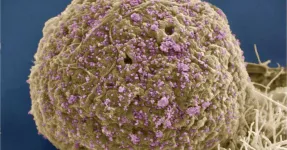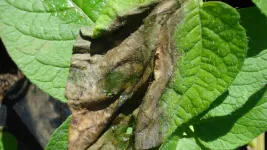(Press-News.org) UNIVERSITY PARK, Pa. — While pollinator populations of many species have plummeted worldwide, one bee species is blowing up the map with its rapid population expansion. The key to this insect’s success? Its passion for pumpkins, zucchinis, and other squashes, and the massive increase in cultivation of these crops across North America over the last 1,000 years.
A new study led by Penn State found that the squash bee (Eucera pruinosa) has evolved in response to intensifying agriculture — namely squashes in the genus Curcurbita. The research is the first to demonstrate the role of agriculture as an evolutionary force acting on a wild insect pollinator and may have implications for food security.
“When we think of insects benefiting from and adapting to widespread agriculture, we tend to think of pests such as certain kinds of moths, flies and beetles,” said Margarita López-Uribe, Lorenzo L. Langstroth Early Career Professor and Associate Professor of Entomology. “But the impact of agricultural intensification on the evolution of beneficial pollinators is poorly understood. We found that agriculture facilitated increases in population size of this squash bee, and this may be the case for other insect pollinators, as well.”
López-Uribe noted that the study is the first to identify adaptive processes of an insect pollinator in response to human agricultural practices. This study demonstrates that human agriculture in North America has had a profound impact on the evolutionary history of an insect that is an essential pollinator of squash crops, she said.
“Pollination is such an important process that impacts so much of the food we eat. Understanding how humans have and continue to impact that process and pollinators — through agriculture, urbanization and in other ways — is key to ensuring we maintain food security,” said Sam Scheiner, program director at the U.S. National Science Foundation, which partially funded the work. “This research highlights how domesticating plants can have important indirect effects on the organisms that pollinate those plants.”
Historically, the squash bee’s (Eucera pruinosa) primary source of pollen was the wild buffalo gourd (Curcurbita foetidissima), a baseball-sized squash that grew in the deserts of Mexico and the southwestern United States. As one of the “Three Sisters,” which includes corn and beans, squash was an important crop of Indigenous Peoples in the Americas, and around 5,000 years ago, Indigenous Peoples of the Eastern Woodlands began to domesticate a relative of C. foetidissima, called C. pepo. Widespread cultivation of the resulting crops — which included pumpkins, squash, and gourds — began later, around 3,000 years ago, and was intensified around 1,000 years ago with the introduction of maize to the agricultural systems of North America.
“By planting squash all over North America, humans created habitat for the squash bee, and that allowed its population to explode,” said López-Uribe. “Today, the squash bee occurs throughout the United States and southeastern Canada — far beyond the range of its original food source.”
To investigate the evolution of the E. pruinosa bee in response to the intensification of Curcurbita agriculture, the team sequenced the bee’s genome, examined its genetic structure — or the amount and distribution of genetic diversity within and among the bee’s various populations — and searched for signatures of adaptation. Decreases in genetic diversity, explained López-Uribe, can indicate ‘selective sweeps’ — or the process by which new beneficial mutations increase in frequency and become fixed.
Next, the team developed a novel algorithm to estimate the bee’s migration and effective population size — or breeding population size — across populations.
The researchers found that the bee’s transition from wild host plants in deserts to temperate agricultural habitats was associated with selective sweeps resulting in substantial reductions in genetic diversity in some parts of the genome.
“Nearly 20% of the bee’s genome appears to be linked to these sweeps,” said López-Uribe.
Particularly linked to these selective sweeps were changes in genes associated with chemosensation — or the translation of chemical signals from the environment to neurological signals that can be interpreted by an organism. In the case of the squash bee, chemosensation refers to its ability to interpret odor compounds produced by flowers.
“Domesticated Curcurbita plants produce floral blends that are simpler than those of the wild Curcurbita plant,” said López-Uribe. “It is likely that E. pruinosa adapted to a new sensory environment in agricultural habitats, which enabled it to expand its range and significantly increase its population size.”
Other authors on the paper include Nathaniel Pope, postdoctoral scholar, University of Oregon; Avehi Singh, graduate student in ecology, Penn State; Karen Kapheim, associate professor of biology, Utah State University; and Anna Childers, computational biologist, and Jay Evans, research entomologist, Bee Research Laboratory, USDA.
This research was supported by the U.S. National Science Foundation, the U.S. Department of Agriculture National Institute of Food and Agriculture, the U.S. Department of Agriculture Agricultural Research Service and Dovetail Genomics.
END
Squash bees flourish in response to agricultural intensification
Squelches idea that all pollinators are suffering at the hands of humans
2023-04-03
ELSE PRESS RELEASES FROM THIS DATE:
Strong ultralight material could aid energy storage, carbon capture
2023-04-03
HOUSTON – (April 3, 2023) – 2D materials get their strength from their atom-thin, sheetlike structure. However, stacking multiple layers of a 2D material will sap it of the qualities that make it so useful.
Rice University materials scientist Jun Lou and collaborators at the University of Maryland showed that fine-tuning interlayer interactions in a class of 2D polymers known as covalent organic frameworks (COFs) can determine the materials’ loss or retention of desirable ...
Calcium sensor helps us to see the stars
2023-04-03
Using cryo-electron microscopy and mass spectrometry, researchers from PSI have deciphered the structure of an ion channel found in the eye while it interacts with the protein calmodulin – a structure that has eluded scientists for three decades. They believe that this interaction could explain how our eyes can achieve such remarkable sensitivity to dim light. Their results are published in the journal PNAS.
As you look at the bright screen of your phone or computer, ion channels in your eyes close in response to the light. This is the final step of a biochemical ...
New research could spur broader use of 2D materials
2023-04-03
They’re considered some of the strongest materials on the planet, but tapping that strength has proved to be a challenge.
2D materials, thinner than the most delicate onionskin paper, have attracted intense interest because of their incredible mechanical properties. Those properties, however, dissipate when the materials are stacked in multiple layers, thus limiting their usefulness.
“Think of a graphite pencil,” says Teng Li, Keystone Professor at the University of Maryland’s (UMD) Department of Mechanical Engineering. “Its core is made of graphite, and graphite ...
April issues of American Psychiatric Association journals cover genetic underpinnings of common disorders, a digital intervention for depression and anxiety in youth, and more
2023-04-03
WASHINGTON, D.C., April 3, 2023 — The latest issues of three of the American Psychiatric Association’s journals, The American Journal of Psychiatry, Psychiatric Services, and The American Journal of Psychotherapy, are now available online.
The April issue of The American Journal of Psychiatry features genetic, neuroimaging, and behavioral neuroscience studies that focus on the underpinnings of mood disorders, psychotic disorders, autism, and stress-related disorders. Highlights from the issue:
Lower Availability of Mitochondrial Complex I in Anterior Cingulate Cortex in ...
Royal reception on Commonwealth Day 2023 for Sri Lankan PhD researcher
2023-04-03
A PhD researcher from the University of Huddersfield’s Global Disaster Resilience Centre (GDRC) was invited by His Majesty The King and The Queen Consort to attend a special reception at Buckingham Palace and more, in celebration of Commonwealth Day 2023.
Malith Senevirathne is a PhD student at the GDRC, within the University’s School of Applied Sciences and a Research Assistant for the CORE project (sCience and human factOr for Resilient sociEty), funded by the European Commission. As ...
Can investigators use household dust as a forensic tool?
2023-04-03
A North Carolina State University-led study found it is possible to retrieve forensically relevant information from human DNA in household dust. After sampling indoor dust from 13 households, the researchers were able to detect DNA from household residents over 90% of the time, and DNA from non-occupants 50% of the time. The work could be a way to help investigators find leads in difficult cases.
Specifically, the researchers were able to obtain single nucleotide polymorphisms, or SNPs, from the dust samples. SNPs are sites within the genome that vary between individuals – corresponding ...
Center for AIDS Research receives $15 million renewal grant from NIH
2023-04-03
The National Institute of Allergy and Infectious Diseases (NIAID), part of the National Institutes of Health, has awarded a five-year, $15.45 million grant to the San Diego Center for AIDS Research (SD CFAR) at UC San Diego, renewing support that extends back to an original establishing grant in 1994 at the height of the AIDS epidemic.
"The grant renewal represents NIAID's continued and enduring investment in our mission to be a critical regional resource in HIV research and education, to advance the discovery and development of ...
Moderate exercise safe for people with muscle pain from statins
2023-04-03
Statin therapy does not exacerbate muscle injury, pain or fatigue in people engaging in moderate-intensity exercise, such as walking, according to a study published today in the Journal of the American College of Cardiology. The findings are reassuring for people who experience muscle pain or fatigue from statins but need to engage in physical activity to keep their cholesterol levels low and their hearts healthy.
Statins have long been the gold standard for lowering LDL or “bad” cholesterol ...
NC State researchers assemble pathogen ‘tree of life’
2023-04-03
A new online tool – the first of its kind for plant pathogens – will help researchers across the globe identify, detect and monitor species of Phytophthora, which have been responsible for plant diseases ranging from the devastating 1840s Irish potato famine to sudden oak death that still plagues West Coast oak population.
The new pathogen “tree of life” provides a plethora of information about each of the more than 192 formally described species – including their evolutionary history and relationships within groups – as well as more than 30 other informally described taxa. It also includes ...
National Institute of Dental and Craniofacial Research marks 75th anniversary
2023-04-03
Alexandria, VA – A symposium to kick off the year-long celebration of the 75th Anniversary of the National Institute of Dental and Craniofacial Research (NIDCR) was featured at the 52nd Annual Meeting & Exhibition of the AADOCR, held in conjunction with the 47th Annual Meeting of the CADR. The AADOCR/CADR Annual Meeting & Exhibition took place at the Oregon Convention Center in Portland on March 15-18, 2023.
The symposium explored a brief history of the founding of NIDCR and its early activities, followed by reflections of the former directors, Harold C. Slavkin, Lawrence A. Tabak and Martha ...
LAST 30 PRESS RELEASES:
Short-circuiting pancreatic cancer
Groundbreaking mapping: how many ghost particles all the Milky Way’s stars send towards Earth
JBNU researchers propose hierarchical porous copper nanosheet-based triboelectric nanogenerators
A high-protein diet can defeat cholera infection
A more accurate way of calculating the value of a healthy year of life
What causes some people’s gut microbes to produce high alcohol levels?
Global study reveals widespread burning of plastic for heating and cooking
MIT study shows pills that communicate from the stomach could improve medication adherence
Searching for the centromere: diversity in pathways key for cell division
Behind nature’s blueprints
Researchers search for why some people’s gut microbes produce high alcohol levels
Researchers find promising new way to boost the immune response to cancer
Coffee as a staining agent substitute in electron microscopy
Revealing the diversity of olfactory receptors in hagfish and its implications for early vertebrate evolution
Development of an ultrasonic sensor capable of cuffless, non-invasive blood pressure measurement
Longer treatment with medications for opioid use disorder is associated with greater probability of survival
Strategy over morality can help conservation campaigns reduce ivory demand, research shows
Rising temperatures reshape microbial carbon cycling during animal carcass decomposition in water
Achieving ultra-low-power explosive jumps via locust bio-hybrid muscle actuators
Plant-derived phenolic acids revive the power of tetracycline against drug-resistant bacteria
Cooperation: A costly affair in bacterial social behaviour?
Viruses in wastewater: Silent drivers of pollution removal and antibiotic resistance
Sub-iethal water disinfection may accelerate the spread of antibiotic resistance
Three in four new Australian moms struggle with body image
Post-stroke injection protects the brain in preclinical study
Cardiovascular risk score predicts multiple eye diseases
Health: estimated one in ten British adults used or interested in GLP-1 medications for weight loss
Exercise to treat depression yields similar results to therapy
Whooping cough vaccination for pregnant women strengthens babies’ immune system
Dramatic decline in new cases of orphanhood in Uganda driven by HIV treatment and prevention programs
[Press-News.org] Squash bees flourish in response to agricultural intensificationSquelches idea that all pollinators are suffering at the hands of humans
